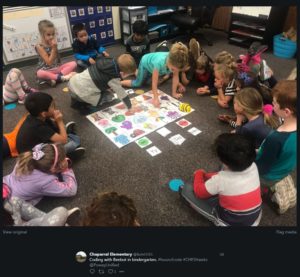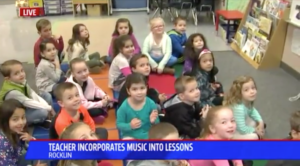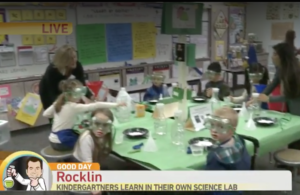
Kindergarten…it’s a time filled with memories of the smells of paste (who wasn’t tempted to eat it at one point in time), imaginary play (house, anyone?), learning how to sit still (I still remember my yarn place on the floor), and listening to stories. I remember learning how to use scissors, writing letters, and even learning how to read.
Over the past couple of years, a number of stories about kindergarten have made their way around social media—many with a negative slant about the state of kindergarten in our nation, calling it “too academic” and with calls for more “play based learning”. I’m not arguing that play-based learning isn’t important, but such stories bring up images of five and six year old children sitting in straight-backed chairs, repeating times tables and engaging in rote memorization activities.
As a mother of three children ages 13, 11 and five, I have struggled with these stories, particularly as I interact with younger mothers who have not had experience with the school system yet, and are afraid that kindergarten will suck the joy of learning out of their children. These stories don’t align with my children’s kindergarten experiences from 8 and 6 years ago (my youngest starts kindergarten next year).
As a marketing and PR consultant for school districts, I also felt like these stories were off base—I have walked through a number of kindergarten classrooms throughout the state of California over the past few years and have found children engaging in art, some academics (for the record, children actually do enjoy learning things like math, science and letters…and savvy and creative kindergarten teachers make this learning fun and engaging), with a balance of play time and lots of social emotional learning time where students discover different ways to manage conflict, make respectful and responsible choices, and learn how to be independent and interdependent in different ways. This hardly sounds like the stuff that would break children’s sweet spirits or ruin their love for lifetime learning.
Yes, kindergarten has changed over the years, and no, I’m not blind to the fact that every child’s and parent’s story will be different–there will be some who have incredibly positive experiences, and others who have negative experiences…and then there are all the stories in between.
Yet, the PR and marketing consultant side of me desired to highlight positive kindergarten stories from colleagues in districts throughout the state of California. And guess what? Kindergarteners still get to have fun, move around, be creative…and they even get more hands-on learning experiences than we did in school!
Before I provide some great examples of kindergarten classes from around the state of California, here are some tips on how to turn around negative or false perceptions of the kindergarten experience:
- Create videos of your kindergarteners in action: Video is the best way to showcase the experience of busy and active students
- Hold a kindergarten parent information night: Rocklin Unified held an excellent info fair for TK and kindergarten parents, and included booths from the school’s library and other services. See the video here.
- Provide kindergarten parents an opportunity to tour kindergarten classrooms: Parents want to see a kindergarten class in action so they can visualize their child in the classroom. This can remove the mystery of “what will my child be doing all day?” from their mindset about kindergarten.
- Appoint a school ambassador to answer incoming kindergarten parents’ questions: Find a current kindergarten parent (or two) and a kindergarten teacher who would be willing to be the point of contact for incoming kindergarten parents. Although your office staff can answer questions, they don’t always have the comforting voice of someone with recent experience in that classroom. Also make sure that these people are scanning local social media groups for questions from parents and providing accurate answers.
- Develop a kindergarten welcome kit: In addition to registration information, include a “What to expect in kindergarten” and FAQ page, along with contact information in case parents have additional questions. Take a poll of current kindergarten families and ask for some shareable quotes to find out what they wished they could have known about kindergarten, and make sure you include those answers in your welcome kit, as well as some great testimonial quotes.
- Consider adding a “New Kindergarten Parent” tab on your schools’, district’s websites: Make sure parents feel welcome and can find information easily on your websites–include the info that you would include in the welcome kit, a video, tour opportunities, and contact information. Include an inquiry form that parents can complete if they want more information or if would like to request a tour.
Note: Ensure that these resources and opportunities are available to parents a couple of months before kindergarten registration.
Here are some great examples kindergarten classrooms across the state! Many thanks to Harry Katcher of Poway Unified School District, Jason Scholl (formerly of Los Altos School District), and Diana Capra of Rocklin Unified School District for sharing these examples from their districts.
Hour of Code-Poway Unified School District, Chaparral Elementary
Who knew kindergarteners could learn to code? Well, when your teacher helps you learn how to use a BeeBot to move to pictures and letters, you get to have a 21st Century hands-on learning experience!
Los Altos School District: Offering an active and engaging kindergarten experience
Check out this video to see how kindergarten students move, create, experience outdoor gardening, lead, and thrive in a nurturing kindergarten environment.
Rocklin Unified School District: Singing Kindergarten Teacher at Breen Elementary
Winter Hungerford, a Rocklin Kindergarten teacher, engages her students with music. Winter believes strongly in using music to engage all students in learning. She also believes music is linked to improved cognitive function, increased language development from an early age, and positive social interaction. Click on the picture below to view the video.
Rocklin Unified School District: Valley View STEM Lab for Kindergarteners
Instead of doing self-made science experiments by eating paste, these kindergarten students get to learn about science in their own science lab. Click on the picture below to view the video.
If you have some examples of how your district makes kindergarten fun, nurturing, engaging and an overall positive learning experience for your youngest students, please send me an email!

 If you do an internet search on “marketing” or “messaging” you usually end up with a bunch of results that don’t really apply to your organization’s needs.
If you do an internet search on “marketing” or “messaging” you usually end up with a bunch of results that don’t really apply to your organization’s needs. 




 pecial, what differentiates it from all others. It drives the customer to make a decision to purchase…or a person to donate to a cause…or parents to choose a school for their child.
pecial, what differentiates it from all others. It drives the customer to make a decision to purchase…or a person to donate to a cause…or parents to choose a school for their child. Take a look at the image to the left: You are likely to recognize most, if not all of the company logos you see. At the same time, you probably also remember something about each company, beyond the actual physical product they sell: maybe it’s a certain feeling, perhaps it’s a certain quality offered by the company, or possibly you are recalling the company’s tagline or services. Strong branding doesn’t happen by mistake–it is the result of a well-researched strategy and approach.
Take a look at the image to the left: You are likely to recognize most, if not all of the company logos you see. At the same time, you probably also remember something about each company, beyond the actual physical product they sell: maybe it’s a certain feeling, perhaps it’s a certain quality offered by the company, or possibly you are recalling the company’s tagline or services. Strong branding doesn’t happen by mistake–it is the result of a well-researched strategy and approach.

